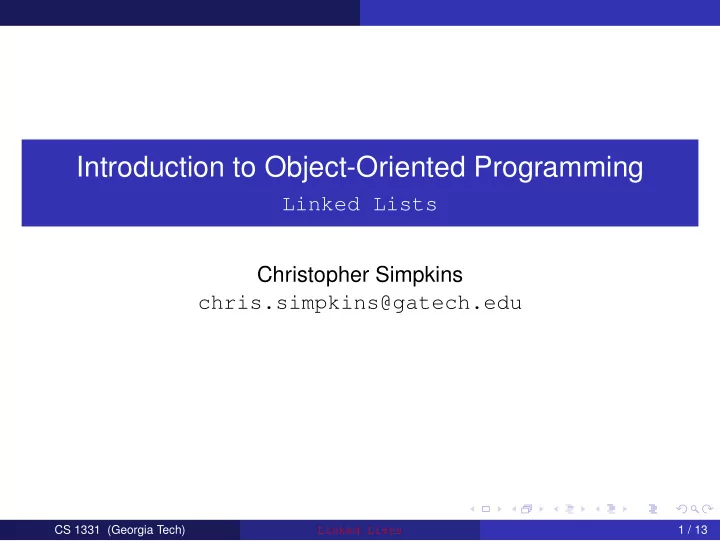

Introduction to Object-Oriented Programming Linked Lists Christopher Simpkins chris.simpkins@gatech.edu CS 1331 (Georgia Tech) 1 / 13 Linked Lists
Linked Lists Dynamic data structures Singly linked lists Generic linked lists Doubly linked lists CS 1331 (Georgia Tech) 2 / 13 Linked Lists
Dynamic Data Structures ArrayList was our first dynamically-allocated data structure. ArrayList is a hybrid static and dynamically allocated data structure. ArrayList automatically allocates a larger backing (static) array when the capacity of its current backing array is exceeded. In a purely dynamic data structure, storage for each new element is allocated when the element is added. A purely dynamically allocated data structure is (slightly) more space efficient, but slower because heap allocation occurs every time an element is added. CS 1331 (Georgia Tech) 3 / 13 Linked Lists
Linked Data Structures The core concept in a linked data structures is the node. A data structure is a collection of nodes linked in a particular way. A node holds a data item and links to other nodes. The nature of the links determines the kind of data structure, e.g., singly linked list, doubly linked list, binary tree, etc. Here is a depiction of a node for a singly linked list and code that implements such a node (public members for brevity) private class Node { public Object data; public Node next; public Node(Object data, Node next) { this.data = data; this.next = next; } } CS 1331 (Georgia Tech) 4 / 13 Linked Lists
Singly Linked Lists A singly linked list Contains a pointer to a “head” node ( null if empty). The head node’s next points to the second node, the second node’s next points to the third node, and so on. The next reference of the last node is null Here’s a depiction of the nodes in a singly linked list with three elements: CS 1331 (Georgia Tech) 5 / 13 Linked Lists
Adding Elements to a Singly Linked List 1. Create a new Node . 2. Set the next reference of the new Node to the current head . 3. Set the head reference to the new Node See LinkedList.java for the code. CS 1331 (Georgia Tech) 6 / 13 Linked Lists
Finding an Item in a Linked List An algorithm for finding an item in a linked list: foundNode: Node := null currentNode: Node := LinkedList.head while currentNode != null && foundNode = null if currentNode.data = queryItem foundNode := currentNode currentNode := currentNode.next The postcondition of this algorithm is that foundNode will be: The node containing the query item, or null if the query item is not in the list. CS 1331 (Georgia Tech) 7 / 13 Linked Lists
Inserting Elements into a Linked List 1. Find the existing Node to insert new element after. 2. Create a new Node . 3. Set the next reference of the new Node to the next reference of the existing node. 4. Set the next reference of the existing node to the new Node . See LinkedList.java for the code. CS 1331 (Georgia Tech) 8 / 13 Linked Lists
Computing the Length of a Linked List An algorithm for computing the length a linked list: length: int := 0 currentNode: Node := LinkedList.head while currentNode != null length := length + 1 currentNode := currentNode.next The postcondition of this algorithm is that length will be equal to the number of nodes in the list. CS 1331 (Georgia Tech) 9 / 13 Linked Lists
Generic Linked Lists To make our LinkedList generic we only need to add a type parameter to the declaration: public class GenericLinkedList<E> { ... and replace Object with E in the body of the class. See GenericLinkedList.java CS 1331 (Georgia Tech) 10 / 13 Linked Lists
Doubly Linked Lists A doubly linked list simply adds a previous reference to the Node class so that the list can be traversed forwards or backwards. private class Node<E> { E data; Node<E> next; Node<E> previous; public Node(E data, Node<E> next, Node<E> previous) { this.data = data; this.next = next; this.previous = previous; } } Doubly linked lists work the same, except that the algorithms for inserting and removing items requires a bit more link fiddling (have to set previous links as well). See DoublyLinkedList.java. CS 1331 (Georgia Tech) 11 / 13 Linked Lists
Running times of List operations CS 1331 (Georgia Tech) 12 / 13 Linked Lists
Programming Exercises Programming Exercise 1 Add a get(int index) method to GenericLinkedList . Add a remove(T item) method to GenericLinkedList . Programming Exercise 2 Implement public static int binarySearch(int[] a, int v) . Return -1 if v is not in a . Bonus: implement public static <T> int binarySearch(T[] a, T v, Comparator<? super T> c) . Return -1 if v is not in a . Bonus: for either of the options above, implement your method using a recursive helper method. Bonus question: if we wanted to implement a similar method for a Collection , how would we do it? Could we define such a binary search method for any Collection ? Bonus question 2: what is the running time (Big-O) of binary search? CS 1331 (Georgia Tech) 13 / 13 Linked Lists
Recommend
More recommend